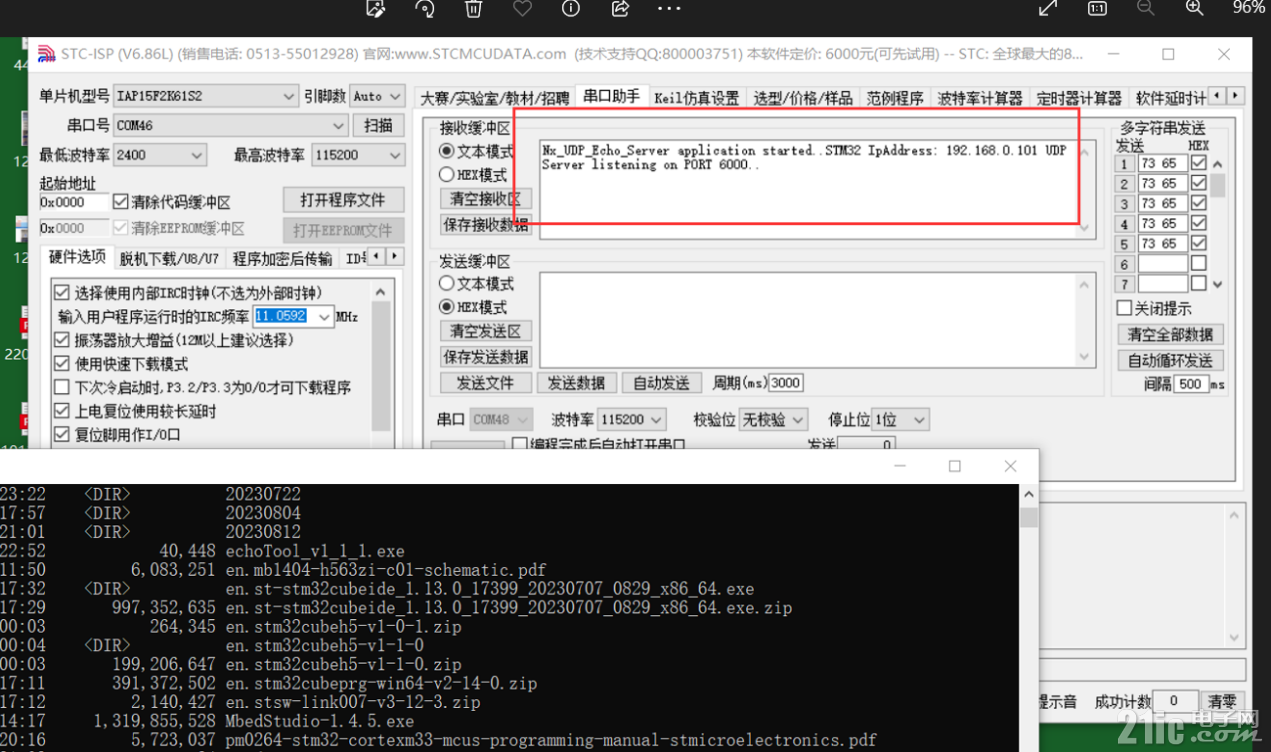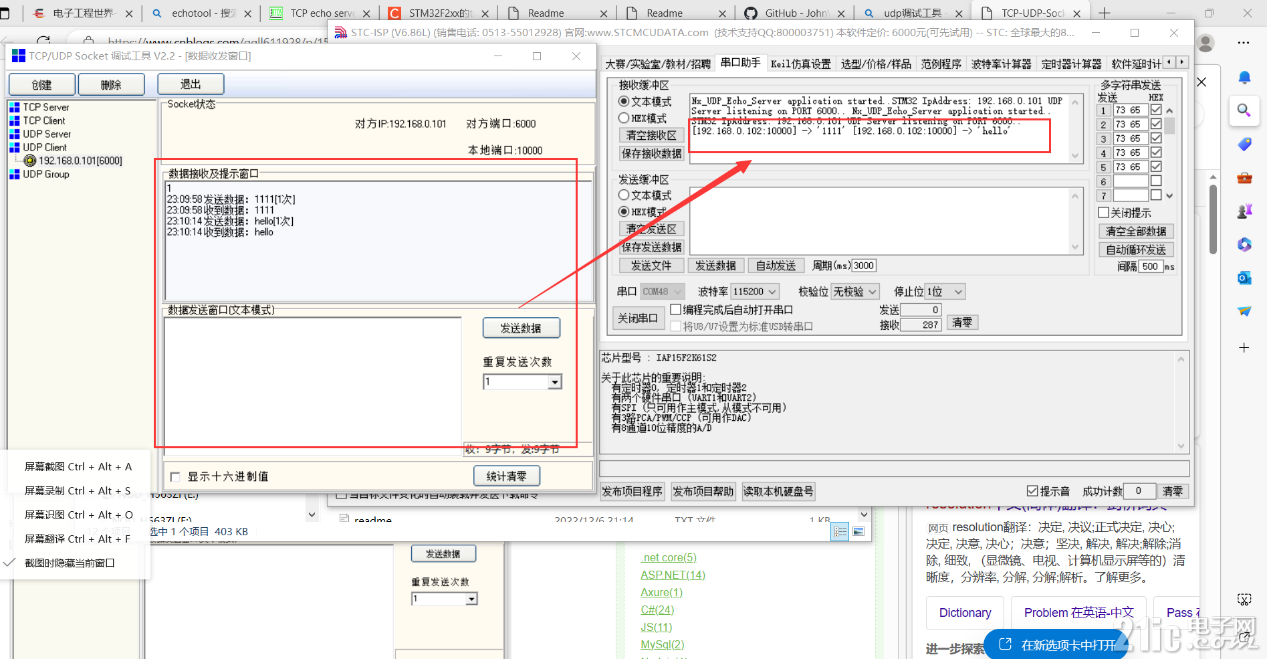本帖最后由 dami 于 2023-8-17 10:53 编辑
【NUCLEO-H563ZI测评】5.NetXDuo UDP服务器
玩了一下THREADX后,发现NetXDuo这个东西蛮好的,那不也得玩一下啊。
下载解压en.stm32cubeh5-v1-1-0。
mdk打开STM32Cube_FW_H5_V1.1.0\Projects\NUCLEO-H563ZI\Applications\NetXDuo\Nx_UDP_Echo_Server\MDK-ARM目录里的Nx_UDP_Echo_Server。

编译下载运行
连接串口和以太网口 串口显示如下

找一个udp的调试软件并创建一个客户端连接这个板子的服务器,发送数据,那边就收到了

主要代码在app_netxduo.c中
MX_NetXDuo_Init(VOID *memory_ptr)中创建各种任务
- UINT MX_NetXDuo_Init(VOID *memory_ptr)
- {
- UINT ret = NX_SUCCESS;
- TX_BYTE_POOL *byte_pool = (TX_BYTE_POOL*)memory_ptr;
- /* USER CODE BEGIN App_NetXDuo_MEM_POOL */
- /* USER CODE END App_NetXDuo_MEM_POOL */
- /* USER CODE BEGIN 0 */
- printf("Nx_UDP_Echo_Server application started..\n");
- /* USER CODE END 0 */
- /* Initialize the NetXDuo system. */
- CHAR *pointer;
- nx_system_initialize();
- /* Allocate the memory for packet_pool. */
- if (tx_byte_allocate(byte_pool, (VOID **) &pointer, NX_APP_PACKET_POOL_SIZE, TX_NO_WAIT) != TX_SUCCESS)
- {
- return TX_POOL_ERROR;
- }
- /* Create the Packet pool to be used for packet allocation,
- * If extra NX_PACKET are to be used the NX_APP_PACKET_POOL_SIZE should be increased
- */
- ret = nx_packet_pool_create(&NxAppPool, "NetXDuo App Pool", DEFAULT_PAYLOAD_SIZE, pointer, NX_APP_PACKET_POOL_SIZE);
- if (ret != NX_SUCCESS)
- {
- return NX_POOL_ERROR;
- }
- /* Allocate the memory for Ip_Instance */
- if (tx_byte_allocate(byte_pool, (VOID **) &pointer, Nx_IP_INSTANCE_THREAD_SIZE, TX_NO_WAIT) != TX_SUCCESS)
- {
- return TX_POOL_ERROR;
- }
- /* Create the main NX_IP instance */
- ret = nx_ip_create(&NetXDuoEthIpInstance, "NetX Ip instance", NX_APP_DEFAULT_IP_ADDRESS, NX_APP_DEFAULT_NET_MASK, &NxAppPool, nx_stm32_eth_driver,
- pointer, Nx_IP_INSTANCE_THREAD_SIZE, NX_APP_INSTANCE_PRIORITY);
- if (ret != NX_SUCCESS)
- {
- return NX_NOT_SUCCESSFUL;
- }
- /* Allocate the memory for ARP */
- if (tx_byte_allocate(byte_pool, (VOID **) &pointer, DEFAULT_ARP_CACHE_SIZE, TX_NO_WAIT) != TX_SUCCESS)
- {
- return TX_POOL_ERROR;
- }
- /* Enable the ARP protocol and provide the ARP cache size for the IP instance */
- /* USER CODE BEGIN ARP_Protocol_Initialization */
- /* USER CODE END ARP_Protocol_Initialization */
- ret = nx_arp_enable(&NetXDuoEthIpInstance, (VOID *)pointer, DEFAULT_ARP_CACHE_SIZE);
- if (ret != NX_SUCCESS)
- {
- return NX_NOT_SUCCESSFUL;
- }
- /* Enable the ICMP */
- /* USER CODE BEGIN ICMP_Protocol_Initialization */
- /* USER CODE END ICMP_Protocol_Initialization */
- ret = nx_icmp_enable(&NetXDuoEthIpInstance);
- if (ret != NX_SUCCESS)
- {
- return NX_NOT_SUCCESSFUL;
- }
- /* Enable TCP Protocol */
- /* USER CODE BEGIN TCP_Protocol_Initialization */
- /* USER CODE END TCP_Protocol_Initialization */
- ret = nx_tcp_enable(&NetXDuoEthIpInstance);
- if (ret != NX_SUCCESS)
- {
- return NX_NOT_SUCCESSFUL;
- }
- /* Enable the UDP protocol required for DHCP communication */
- /* USER CODE BEGIN UDP_Protocol_Initialization */
- /* USER CODE END UDP_Protocol_Initialization */
- ret = nx_udp_enable(&NetXDuoEthIpInstance);
- if (ret != NX_SUCCESS)
- {
- return NX_NOT_SUCCESSFUL;
- }
- /* Allocate the memory for main thread */
- if (tx_byte_allocate(byte_pool, (VOID **) &pointer, NX_APP_THREAD_STACK_SIZE, TX_NO_WAIT) != TX_SUCCESS)
- {
- return TX_POOL_ERROR;
- }
- /* Create the main thread */
- ret = tx_thread_create(&NxAppThread, "NetXDuo App thread", App_Main_Thread_Entry , 0, pointer, NX_APP_THREAD_STACK_SIZE,
- NX_APP_THREAD_PRIORITY, NX_APP_THREAD_PRIORITY, TX_NO_TIME_SLICE, TX_AUTO_START);
- if (ret != TX_SUCCESS)
- {
- return TX_THREAD_ERROR;
- }
- /* Create the DHCP client */
- /* USER CODE BEGIN DHCP_Protocol_Initialization */
- /* USER CODE END DHCP_Protocol_Initialization */
- ret = nx_dhcp_create(&DHCPClient, &NetXDuoEthIpInstance, "DHCP Client");
- if (ret != NX_SUCCESS)
- {
- return NX_DHCP_ERROR;
- }
- /* set DHCP notification callback */
- tx_semaphore_create(&DHCPSemaphore, "DHCP Semaphore", 0);
- /* USER CODE BEGIN MX_NetXDuo_Init */
- /* Allocate the app UDP thread entry pool. */
- ret = tx_byte_allocate(byte_pool, (VOID **) &pointer, 2 * DEFAULT_MEMORY_SIZE, TX_NO_WAIT);
- if (ret != TX_SUCCESS)
- {
- return TX_POOL_ERROR;
- }
- /* create the UDP server thread */
- ret = tx_thread_create(&AppUDPThread, "App UDP Thread", App_UDP_Thread_Entry, 0, pointer, 2 * DEFAULT_MEMORY_SIZE,
- DEFAULT_PRIORITY, DEFAULT_PRIORITY, TX_NO_TIME_SLICE, TX_DONT_START);
- if (ret != TX_SUCCESS)
- {
- return TX_THREAD_ERROR;
- }
- /* Allocate the memory for Link thread */
- if (tx_byte_allocate(byte_pool, (VOID **) &pointer,2 * DEFAULT_MEMORY_SIZE, TX_NO_WAIT) != TX_SUCCESS)
- {
- return TX_POOL_ERROR;
- }
- /* create the Link thread */
- ret = tx_thread_create(&AppLinkThread, "App Link Thread", App_Link_Thread_Entry, 0, pointer, 2 * DEFAULT_MEMORY_SIZE,
- LINK_PRIORITY, LINK_PRIORITY, TX_NO_TIME_SLICE, TX_AUTO_START);
- if (ret != TX_SUCCESS)
- {
- return TX_THREAD_ERROR;
- }
- /* USER CODE END MX_NetXDuo_Init */
- return ret;
- }
- static VOID ip_address_change_notify_callback(NX_IP *ip_instance, VOID *ptr)
- {
- /* USER CODE BEGIN ip_address_change_notify_callback */
- /* USER CODE END ip_address_change_notify_callback */
- /* release the semaphore as soon as an IP address is available */
- tx_semaphore_put(&DHCPSemaphore);
- }
- /**
- * [url=home.php?mod=space&uid=247401]@brief[/url] Main thread entry.
- * @param thread_input: ULONG user argument used by the thread entry
- * @retval none
- */
- static VOID App_Main_Thread_Entry (ULONG thread_input)
- {
- /* USER CODE BEGIN Nx_App_Thread_Entry 0 */
- /* USER CODE END Nx_App_Thread_Entry 0 */
- UINT ret = NX_SUCCESS;
- /* USER CODE BEGIN Nx_App_Thread_Entry 1 */
- /* USER CODE END Nx_App_Thread_Entry 1 */
- /* register the IP address change callback */
- ret = nx_ip_address_change_notify(&NetXDuoEthIpInstance, ip_address_change_notify_callback, NULL);
- if (ret != NX_SUCCESS)
- {
- /* USER CODE BEGIN IP address change callback error */
- Error_Handler();
- /* USER CODE END IP address change callback error */
- }
- /* start the DHCP client */
- ret = nx_dhcp_start(&DHCPClient);
- if (ret != NX_SUCCESS)
- {
- /* USER CODE BEGIN DHCP client start error */
- Error_Handler();
- /* USER CODE END DHCP client start error */
- }
- /* wait until an IP address is ready */
- if(tx_semaphore_get(&DHCPSemaphore, NX_APP_DEFAULT_TIMEOUT) != TX_SUCCESS)
- {
- /* USER CODE BEGIN DHCPSemaphore get error */
- Error_Handler();
- /* USER CODE END DHCPSemaphore get error */
- }
- /* USER CODE BEGIN Nx_App_Thread_Entry 2 */
- /* get IP address */
- ret = nx_ip_address_get(&NetXDuoEthIpInstance, &IpAddress, &NetMask);
- /* print the IP address */
- PRINT_IP_ADDRESS(IpAddress);
- if (ret != TX_SUCCESS)
- {
- Error_Handler();
- }
- /* Now the network is correctly initialized, start the UDP server thread */
- tx_thread_resume(&AppUDPThread);
- /* this thread is not needed any more, we relinquish it */
- tx_thread_relinquish();
- /* USER CODE END Nx_App_Thread_Entry 2 */
- }
- /* USER CODE BEGIN 1 */
- static VOID App_UDP_Thread_Entry(ULONG thread_input)
- {
- UINT ret;
- ULONG bytes_read;
- UINT source_port;
- UCHAR data_buffer[512];
- ULONG source_ip_address;
- NX_PACKET *data_packet;
- /* create the UDP socket */
- ret = nx_udp_socket_create(&NetXDuoEthIpInstance, &UDPSocket, "UDP Server Socket", NX_IP_NORMAL, NX_FRAGMENT_OKAY, NX_IP_TIME_TO_LIVE, QUEUE_MAX_SIZE);
- if (ret != NX_SUCCESS)
- {
- Error_Handler();
- }
- /* bind the socket indefinitely on the required port */
- ret = nx_udp_socket_bind(&UDPSocket, DEFAULT_PORT, TX_WAIT_FOREVER);
- if (ret != NX_SUCCESS)
- {
- Error_Handler();
- }
- else
- {
- printf("UDP Server listening on PORT %d.. \n", DEFAULT_PORT);
- }
- while(1)
- {
- TX_MEMSET(data_buffer, '\0', sizeof(data_buffer));
- /* wait for data for 1 sec */
- ret = nx_udp_socket_receive(&UDPSocket, &data_packet, 100);
- if (ret == NX_SUCCESS)
- {
- /* data is available, read it into the data buffer */
- nx_packet_data_retrieve(data_packet, data_buffer, &bytes_read);
- /* get info about the client address and port */
- nx_udp_source_extract(data_packet, &source_ip_address, &source_port);
- /* print the client address, the remote port and the received data */
- PRINT_DATA(source_ip_address, source_port, data_buffer);
- /* resend the same packet to the client */
- ret = nx_udp_socket_send(&UDPSocket, data_packet, source_ip_address, source_port);
- /* toggle the green led to monitor visually the traffic */
- HAL_GPIO_TogglePin(GPIOB, GPIO_PIN_0);
- }
- else
- {
- /* the server is in idle state, toggle the green led */
- HAL_GPIO_TogglePin(GPIOB, GPIO_PIN_0);
- }
- }
- }
- /**
- * [url=home.php?mod=space&uid=247401]@brief[/url] Link thread entry
- * @param thread_input: ULONG thread parameter
- * @retval none
- */
- static VOID App_Link_Thread_Entry(ULONG thread_input)
- {
- ULONG actual_status;
- UINT linkdown = 0, status;
- while(1)
- {
- /* Get Physical Link status. */
- status = nx_ip_interface_status_check(&NetXDuoEthIpInstance, 0, NX_IP_LINK_ENABLED,
- &actual_status, 10);
- if(status == NX_SUCCESS)
- {
- if(linkdown == 1)
- {
- linkdown = 0;
- status = nx_ip_interface_status_check(&NetXDuoEthIpInstance, 0, NX_IP_ADDRESS_RESOLVED,
- &actual_status, 10);
- if(status == NX_SUCCESS)
- {
- /* The network cable is connected again. */
- printf("The network cable is connected again.\n");
- /* Print UDP Echo Server is available again. */
- printf("UDP Echo Server is available again.\n");
- }
- else
- {
- /* The network cable is connected. */
- printf("The network cable is connected.\n");
- /* Send command to Enable Nx driver. */
- nx_ip_driver_direct_command(&NetXDuoEthIpInstance, NX_LINK_ENABLE,
- &actual_status);
- /* Restart DHCP Client. */
- nx_dhcp_stop(&DHCPClient);
- nx_dhcp_start(&DHCPClient);
- }
- }
- }
- else
- {
- if(0 == linkdown)
- {
- linkdown = 1;
- /* The network cable is not connected. */
- printf("The network cable is not connected.\n");
- }
- }
- tx_thread_sleep(NX_ETH_CABLE_CONNECTION_CHECK_PERIOD);
- }
- }
- /* USER CODE END 1 */
|